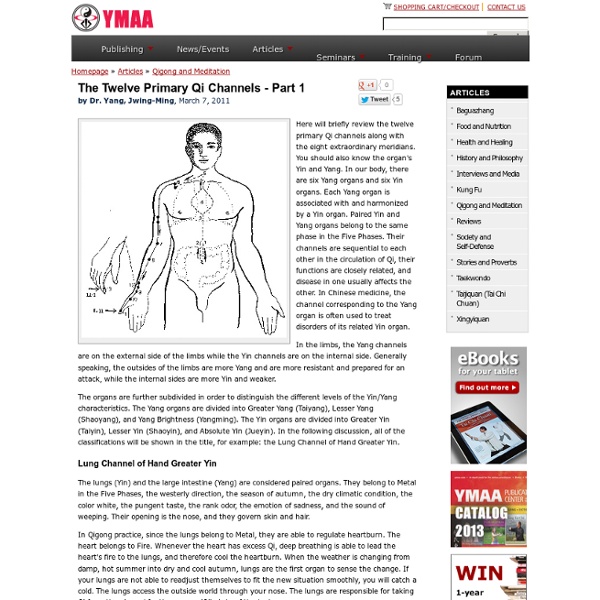The Twelve Primary Qi Channels - Part 1

Welcome to the National Qigong Association (Chi Kung)
“A Glimpse of the True Nature and High Potential of Chi power”
“I am trying to keep an open mind. Can someone show a video clip of a Taichi Master throwing animals like a big dog or a bear? That will certainly convince me”.- therainbowsurf, top rated You Tube commentator From the YouTube video’s description: Ven Lama Dondrup Dorje, a renowned master, teacher of international champions who collected 370 gold medals from 1992 to 1998; here demonstates at the Fifth International Chinese Internal Arts Festival, England in 1996. From The Pathgate website: Qi is the Intrinsic Energy which sustains the configuration and integrity of all forms and substances in the Universe. I’ve always been amazed at the unbelievable claims made regarding “chi” energy. At the end of this video there are some suggestions from the world famous martial arts master George Dillman regarding advanced combat techniques which may help you defend yourself against a “chi” attack, should an assailant decide to use their incredible powers upon you! In summary these include: Footnotes:
Qigong Energy & Magnets
What Is Qi (Chi)?
What Is Qi (Chi)? Central to Taoist world-view and practice is qi (chi). Qi is life-force -- that which animates the forms of the world. It is the vibratory nature of phenomena -- the flow and tremoring that is happening continuously at molecular, atomic and sub-atomic levels. In Japan it is called “ki,” and in India, “prana” or “shakti.” In China, the understanding of qi is inherent in the very language. Many Different Kinds of Qi Practitioners of Chinese Medicine and qigong have identified many different kinds of qi. Balanced & Free-Flowing Qi = Health The fundamental insight of qigong and Chinese Medicine (acupuncture and herbal medicine) is that balanced and free-flowing qi results in health; while stagnant or imbalanced qi leads to disease. Feeling the Qi The capacity to perceive the flow of qi directly -- to actually see or feel it -- is something that can be cultivated through training in qigong or acupuncture. Recommended reading: Orr, Katherine. Of Related Interest:
Baduanjin qigong
The Baduanjin qigong(八段錦) is one of the most common forms of Chinese qigong used as exercise.[1] Variously translated as Eight Pieces of Brocade, Eight-Section Brocade, Eight Silken Movements and others, the name of the form generally refers to how the eight individual movements of the form characterize and impart a silken quality (like that of a piece of brocade) to the body and its energy. The Baduanjin is primarily designated as a form of medical qigong, meant to improve health.[2] This is in contrast to religious or martial forms of qigong. However, this categorization does not preclude the form's use by martial artists as a supplementary exercise, and this practice is frequent.[2] History[edit] This exercise is mentioned in several encyclopedias originating from the Song Dynasty. Nineteenth century sources attribute the style to semi-legendary Chinese folk hero General Yue Fei,[4] and describe it as being created as a form of exercise for his soldiers. The sections[edit]
Meditation changes temperatures
Mind controls body in extreme experiments By William J. Cromie Gazette Staff In a monastery in northern India, thinly clad Tibetan monks sat quietly in a room where the temperature was a chilly 40 degrees Fahrenheit. Using a yoga technique known as g Tum-mo, they entered a state of deep meditation. Other monks soaked 3-by-6-foot sheets in cold water (49 degrees) and placed them over the meditators' shoulders. If body temperatures continue to drop under these conditions, death can result. Attendants removed the sheets, then covered the meditators with a second chilled, wet wrapping. Why would anyone do this? Benson is an associate professor of medicine at the Harvard Medical School and president of the Mind/Body Medical Institute at Beth Israel Deaconess Medical Center in Boston. Benson developed the "relaxation response," which he describes as "a physiological state opposite to stress." Breathtaking results Overcoming obstacles Meditation...
Related:
Related:



